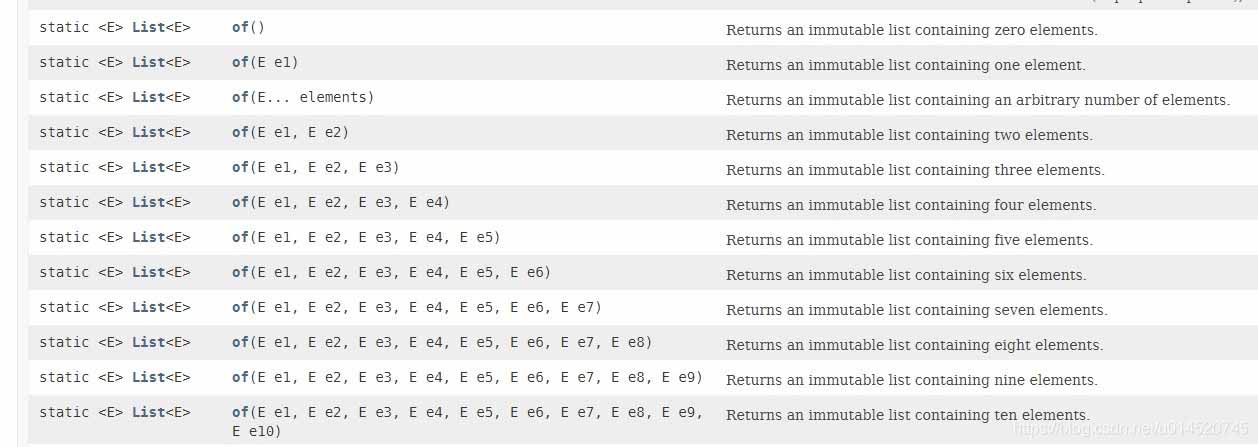您好,登錄后才能下訂單哦!
您好,登錄后才能下訂單哦!
這篇文章主要為大家展示了“Java9中集合類擴展of方法的示例分析”,內容簡而易懂,條理清晰,希望能夠幫助大家解決疑惑,下面讓小編帶領大家一起研究并學習一下“Java9中集合類擴展of方法的示例分析”這篇文章吧。
package com.jd.collections;
import org.junit.Test;
import java.util.List;
import java.util.Map;
import java.util.Optional;
import java.util.Set;
import java.util.stream.IntStream;
import java.util.stream.Stream;
public class StreamTest {
@Test
public void testSet() {
Set<Integer> integerSet = Set.of(1, 2, 3, 4, 5, 6, 7, 8);
System.out.println(integerSet);
}
@Test
public void testList() {
List<Integer> integerSet = List.of(1, 2, 3, 4, 5, 6, 7, 8);
System.out.println(integerSet);
}
@Test
public void testMap() {
Map<String, String> stringMap = Map.of("k1", "v1", "k2", "v2", "k3", "v3");
System.out.println(stringMap);
Map.Entry<String, String> entry1 = Map.entry("k1", "v1");
Map.Entry<String, String> entry2 = Map.entry("k11", "v11");
Map.Entry<String, String> entry3 = Map.entry("k12", "v12");
Map<String, String> mapOfEntries = Map.ofEntries(entry1, entry2, entry3);
System.out.println(mapOfEntries);
}
@Test
public void testStream1() {
Optional<Integer> integerOptional = Stream.ofNullable(Integer.valueOf("1232")).findAny();
System.out.println(integerOptional.get());
}
@Test
public void testStream2() {
Stream.of(1, 2, 3, 4, 5, 6).dropWhile(x -> x == 6)/*.takeWhile(x -> x == 2)*/.forEach(System.out::println);
}
@Test
public void testStream3() {
IntStream.of(1, 2, 3, 4, 5, 6).forEach(System.out::println);
}
@Test
public void testStream4() {
IntStream.iterate(1, i -> i < 10, i -> i + 2).forEach(System.out::println);
}
// @Test
// public void testFlow() {
// Flow.Processor
// }
}在java9 api的集合類中,有很多看似一樣的重載of方法:

那這里有個問題是為什么有了VarArgs(可變長參數)方法,還需要定義那么多重載的方法呢?查看官方的更新日志中可以發現
http://openjdk.java.net/jeps/269
These will include varargs overloads, so that there is no fixed limit on the collection size. However, the collection instances so created may be tuned for smaller sizes. Special-case APIs (fixed-argument overloads) for up to ten of elements will be provided. While this introduces some clutter in the API, it avoids array allocation, initialization, and garbage collection overhead that is incurred by varargs calls. Significantly, the source code of the call site is the same regardless of whether a fixed-arg or varargs overload is called.
大致得意思是,雖然重載了這么多of方法會造成api的混亂,但它避免了varargs調用引起的數組分配,初始化和垃圾收集開銷。因為固定參數的重載方法,返回的是一個immutable list(不可變集合)。
以上是“Java9中集合類擴展of方法的示例分析”這篇文章的所有內容,感謝各位的閱讀!相信大家都有了一定的了解,希望分享的內容對大家有所幫助,如果還想學習更多知識,歡迎關注億速云行業資訊頻道!
免責聲明:本站發布的內容(圖片、視頻和文字)以原創、轉載和分享為主,文章觀點不代表本網站立場,如果涉及侵權請聯系站長郵箱:is@yisu.com進行舉報,并提供相關證據,一經查實,將立刻刪除涉嫌侵權內容。